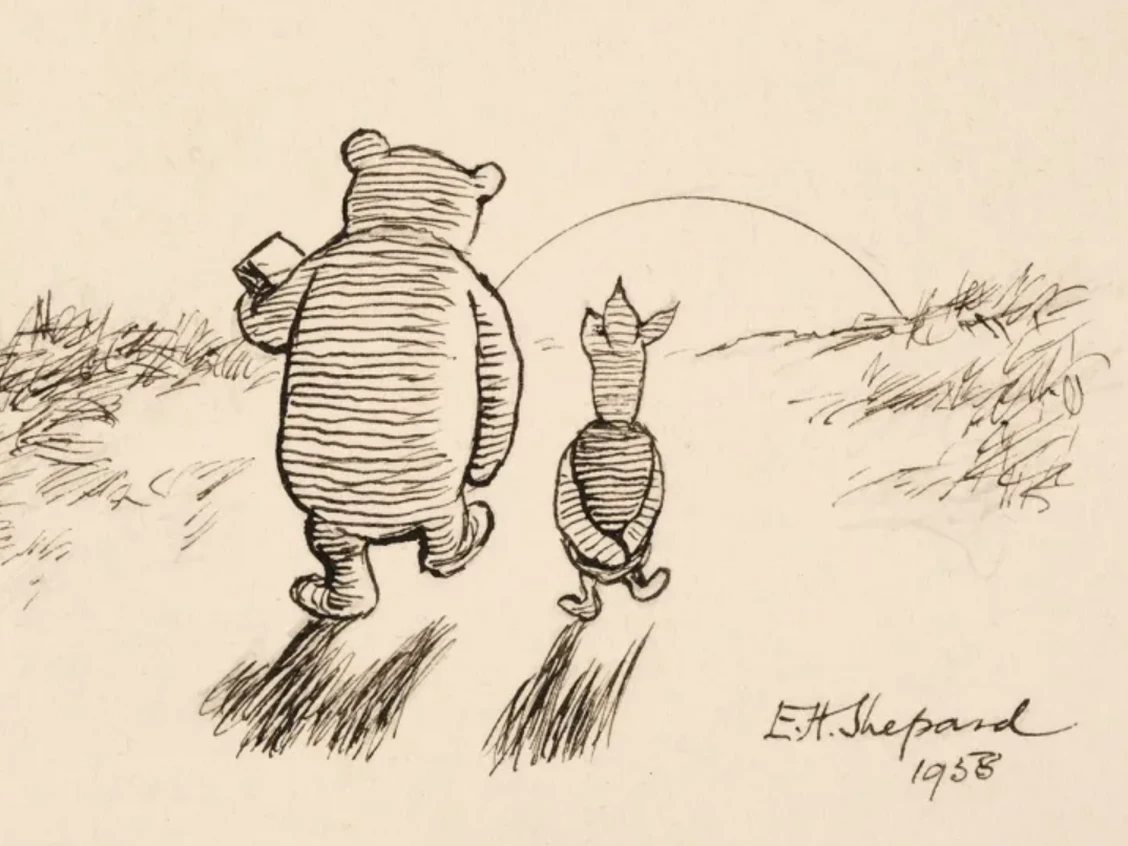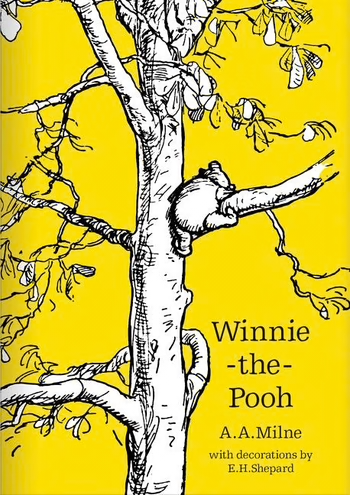Nieman: A bear and his friends have helped children find their way for a century

A Winnie-the-Pooh drawing by illustrator E.H. Shepard was found wrapped in a tea towel. The ‘fantastically poignant’ sketch of Pooh and Piglet was discovered in the cellar of Christopher Foyle, former chairman of Foyles bookshops. It is dated 1958 and signed by E.H. Shepard, the artist who drew the illustrations for A.A. Milne’s 1926 book Winnie-the-Pooh. Credit: Dominic Winter Auctioneers
By Dr. Peter Nieman, Calgary Herald February 22, 2025
About one week ago, my wife and I found ourselves in New York City. It was a cold and blustery day. The mercury dropped to a few degrees below zero. Canadians, one would think, would be all prepared for the cold; we were not.
We spotted the statues of the two lions in front of the New York City Public Library and entered as soon as possible to warm up. Little did we know what was waiting for us.
We stumbled, unexpectantly, upon an exhibit of a special bear – the original Winnie the Pooh; the toy that had belonged to the son of the author of the 1926 book Winnie-the-Pooh. A.A. Milne named the Christopher character after his own child. Next to the stuffed bear, Winnie, were Pooh’s friends, Eeyore the donkey, Kanga, Tigger and Piglet … all there in their original forms.
Winnie the Pooh bear is famous for his love of honey and for being a bear of “little brain.” Winnie’s home in the Hundred Acre Wood contributed to the image of innocence and collaboration with friends.
The book was birthed at the time that is widely known as the “golden age” of children’s literature, which extended from the mid-19th century to the First World War. This was when a child’s world was seen as a time of innocence; a time before the imposed “horrors” of schools, bullies and intense competition and comparisons existed.
The book also taught us about caring for one another. One notable example is where Pooh finds himself stuck in the doorway of Rabbit’s house. He has to wait a week to be thin enough to be pulled free. Christopher Robin then sits down with Pooh and reads him a sustaining book, a book that would help and comfort Pooh: Wedged Bear in Great Tightness.

Winnie-the-Pooh, By A. A. Milne, Illustrated by E. H. Shepard. Winnie-the-Pooh Classic Editions. HarperCollins Publishers
Much has been written about the reason why the toy became known as Winnie-the-Pooh, which was named for a real bear cub called Winnipeg. The book was written at a time when toys were the tools to learn about socialization; where children were welcome to exist in a world of their own innocent imagination.
Many iconic books have contributed to the prosocial development of generations of children, learning about life, about play, and caring for each other. The books by Milne are no exception and perhaps are seen as one of the most influential ever.
I have lots of books in my study at home and on the shelves in my office. They do take up a lot of space and one day when I shared with one of my patients, an avid reader, that, “My wife thinks I have too many books and I need your help. Can you write her a note please?” This little guy, aged eight, responded with this note: “The more you read the more you learn. So you can never have to much book’s” (sic).
I showed it to my wife and, of course, she smiled.
A few years later, our son died by suicide. In the weeks following Ben’s death, my wife’s soul was soothed at bedtime – one of the toughest times of the day along the grief journey – by a book called The Boy, the Mole, the Fox and the Horse written by Charlie Mackesy. One line stood out. It was a conversation between the boy and the horse. “What is the bravest thing you ever said?” asked the boy. “Help,” said the horse.
We shared the book with parents who also lost a child due to suicide. It spoke to these parents and we gifted the book many times.
A few days ago, we arrived in Cape Town, South Africa, and at the house we rented there were many bedrooms to choose from. As synchronicity would have it, after we chose a room, we noticed by my wife’s side of the bed was a copy of The Boy, the Mole, the Fox and the Horse.” She sobbed. I hugged her and we knew that we were not alone.
As we learned from the characters in Winnie-the-Pooh, sometimes we cannot fix each other’s pain but we can hang together. We can carry each other’s burdens. We can be here now. With loving awareness, we can all ask what another author, Wayne Dyer, asked himself daily: How may I serve, and how may I love?
| Dr. Nieman is the founder of Centre 70. He has contributed columns to the Herald since 1999. He has just completed his 117th marathon – this time in Cape Town. |
 Source Calgary Herald
Source Calgary Herald
Also see
Nieman: Lessons learned from families over four decades Calgary Herald
